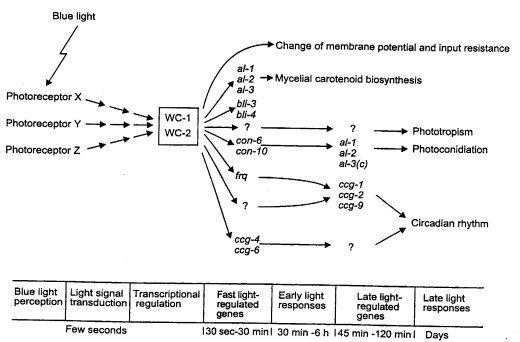
wa : washed
VR. Between al-3, inl (6%), pk, T(EB4)L and ad-7 (4%) (1546, 1578, 1585).
Surface growth is spreading and thin on minimal medium, with sparse conidiation (1585). Restricted and colonial on glycerol complete medium. Called spco-2 (719).
wc : white collar
Carotenoids are absent from mycelia, whereas conidia become pigmented (although slowly). Named for the appearance of the mutant in agar slants, where a nonconidiating rim at the top of the slant remains white. A double mutant of wc with fluffy or another nonconidiating gene remains white and would be classed as albino. The wc-1 and wc-2 genes encode regulatory proteins that are involved in blue-light- induced transcriptional control (1205).

FIGURE 67 A model of photoresponses mediated by WC-1 and WC-2. Photoreceptors
(unidentified) respond to light
and trigger the activation of WC-1 and WC-2. This leads to the activation of both fast- and
late-responding genes.
In addition to inducing transcriptional responses for the genes indicated (and other genes
indicated by question marks),
signals mediated by WC-1 and WC-2 result in other alterations, such as a change in membrane
potential.
Redrawn from ref. (1206 ).
wc-1 : white collar-1
VIIR. Between met-9 (1%; 4%) and for (6%) (1417, 1585, 1592).
Cloned and sequenced: Swissprot WC1_NEUCR, EMBL/GenBank X94300, GenBank NCDNAWC1, PIR S69206.
Blue-light-response regulator, encoding a GATA-family zinc-finger protein that appears to act as a transcription factor with the wc-2 gene product (Fig. 67) (91, 93, 1206, 1225). Mutants are blind (515, 1141, 1208). Homodimerization and heterodimerization (with WC-2) demonstrated in vitro (92); the complex of WC-1 and WC-2 has been observed in vivo (2040). Light-dependent hyperphosphorylation of WC-1 is related to protein turnover (2040). Plays an essential role in establishing the circadian oscillator (144, 431). Useful as a genetic marker (1418, 1556). Scoring is clearest at high temperatures (34ºC). T(P73B159) is inseparable from wc-1 (1578).
wc-2 : white collar-2
IR. Between thi-1 (8%), T(ALS182) and ad-9 (7%; 20%) (1582).
Cloned and sequenced: Swissprot WC2_NEUCR, EMBL/GenBank Y09119, GenBank NCWC2.
Resembles wc-1 phenotypically. A regulator of the blue light response, encoding a GATA-family zinc-finger protein that appears to act as a transcription factor, possibly interacting with WC-1 (91, 1206, 1207, 1225). Mutants are blind (515, 1141, 1208). Homodimerization and heterodimerization (with WC-1) in vitro (92); the complex of WC-1 and WC-2 has been observed in vivo (2040). Essential in establishing the circadian oscillator (144, 431).
ws-1 : white spore-1
VIR. Between trp-2 (38%), T(UK14.1), T(OY320) and Tip-IVR (1578, 1618).
Ascospores fail to darken or do so slowly. Expressed autonomously. Black spots appear on some ws-1 ascospores. In aged crosses, a few percent of ws-1 ascospores darken and are capable of germination. Fertile and prototrophic, with normal tyrosinase activity vegetatively. Photograph of segregating asci (1618). Second-division segregation frequencies of 80 and 96% (1138, 1618) are significantly greater than two-thirds, providing evidence for chiasma interference.
ws-2 : white spore-2
VI. Linked to ylo-1 (16%), trp-2 (2%), Cen-VI (9%; 24%). Recombines with ws-1 (1102, 1138, 1616).
Ascospores are white initially, browning with age. Expressed autonomously (1592).
Return to the 2000 Neurospora compendium main page